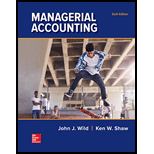
Concept introduction:
Cycle efficiency:
Cycle efficiency denotes about the use of cycle time in value-added activities. In other words, we can say that cycle efficiency shows relationship between value-added time and cycle time. On the basis of cycle efficiency we know about the use of whole cycle time in the value-added activities.
Requirement 1:
Non-value-added time under the traditional manufacturing process.
Answer to Problem 3P
Explanation of Solution
Concept introduction:
Cycle efficiency:
Cycle efficiency denotes about the use of cycle time in value-added activities. In other words, we can say that cycle efficiency shows relationship between value-added time and cycle time. On the basis of cycle efficiency, we know about the use of whole cycle time in the value-added activities.
Requirement 2:
Cycle efficiency under the traditional manufacturing process.
Answer to Problem 3P
Explanation of Solution
Concept introduction:
Cycle efficiency:
Cycle efficiency denotes about the use of cycle time in value-added activities. In other words, we can say that cycle efficiency shows relationship between value-added time and cycle time. On the basis of cycle efficiency, we know about the use of whole cycle time in the value-added activities.
Requirement 3:
Non-value-added time under the proposed lean manufacturing process.
Answer to Problem 3P
Explanation of Solution
Concept introduction:
Cycle efficiency:
Cycle efficiency denotes about the use of cycle time in value-added activities. In other words, we can say that cycle efficiency shows relationship between value-added time and cycle time. On the basis of cycle efficiency, we know about the use of whole cycle time in the value-added activities.
Requirement 4:
Cycle efficiency under the proposed lean manufacturing process.
Answer to Problem 3P
Explanation of Solution
Concept introduction:
Cycle efficiency:
Cycle efficiency denotes about the use of cycle time in value-added activities. In other words, we can say that cycle efficiency shows relationship between value-added time and cycle time. On the basis of cycle efficiency we know about the use of whole cycle time in the value-added activities.
Requirement 5:
Would the proposed lean approach improve cycle efficiency?
Answer to Problem 3P
Yes, the proposed lean approach would improve cycle efficiency.
Explanation of Solution
Want to see more full solutions like this?
Chapter C Solutions
Managerial Accounting
- I need help with this financial accounting question using standard accounting techniques.arrow_forwardI am searching for the correct answer to this financial accounting problem with proper accounting rules.arrow_forwardCan you help me solve this financial accounting question using valid financial accounting techniques?arrow_forward
- Sisu, Oliver and Jones are partners. They share profits and losses in the ratios 2/5,2/5 and 1/5 respectively. For the year ended 31 December 19x6 their capital accounts remained fixed at the following amounts Sisu R6000 Oliver R4000 Jones R2000 They have agreed to give each other 10 per cent per annum on their capital accounts. In addition to the above partnership salaries of R3000 for Oliver and R1000 for Jones are to be charged. The net profit of the partnership before taking any of the above into account was R25200. You are required to draw up the appropriation statement of the partnership for the year ended 31 December 19x6arrow_forwardPlease explain the solution to this general accounting problem using the correct accounting principles.arrow_forwardPlease explain the solution to this financial accounting problem using the correct financial principles.arrow_forward
 Cornerstones of Cost Management (Cornerstones Ser...AccountingISBN:9781305970663Author:Don R. Hansen, Maryanne M. MowenPublisher:Cengage Learning
Cornerstones of Cost Management (Cornerstones Ser...AccountingISBN:9781305970663Author:Don R. Hansen, Maryanne M. MowenPublisher:Cengage Learning Managerial Accounting: The Cornerstone of Busines...AccountingISBN:9781337115773Author:Maryanne M. Mowen, Don R. Hansen, Dan L. HeitgerPublisher:Cengage Learning
Managerial Accounting: The Cornerstone of Busines...AccountingISBN:9781337115773Author:Maryanne M. Mowen, Don R. Hansen, Dan L. HeitgerPublisher:Cengage Learning Excel Applications for Accounting PrinciplesAccountingISBN:9781111581565Author:Gaylord N. SmithPublisher:Cengage Learning
Excel Applications for Accounting PrinciplesAccountingISBN:9781111581565Author:Gaylord N. SmithPublisher:Cengage Learning Managerial AccountingAccountingISBN:9781337912020Author:Carl Warren, Ph.d. Cma William B. TaylerPublisher:South-Western College Pub
Managerial AccountingAccountingISBN:9781337912020Author:Carl Warren, Ph.d. Cma William B. TaylerPublisher:South-Western College Pub Essentials of Business Analytics (MindTap Course ...StatisticsISBN:9781305627734Author:Jeffrey D. Camm, James J. Cochran, Michael J. Fry, Jeffrey W. Ohlmann, David R. AndersonPublisher:Cengage Learning
Essentials of Business Analytics (MindTap Course ...StatisticsISBN:9781305627734Author:Jeffrey D. Camm, James J. Cochran, Michael J. Fry, Jeffrey W. Ohlmann, David R. AndersonPublisher:Cengage Learning Principles of Cost AccountingAccountingISBN:9781305087408Author:Edward J. Vanderbeck, Maria R. MitchellPublisher:Cengage Learning
Principles of Cost AccountingAccountingISBN:9781305087408Author:Edward J. Vanderbeck, Maria R. MitchellPublisher:Cengage Learning





